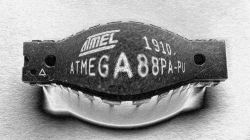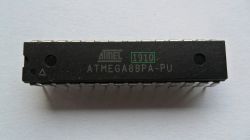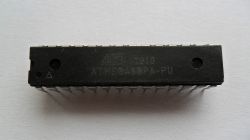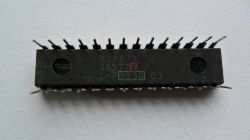Counterfeit ATtiny/ATmega microcontrollers in DIP housings
While shopping on AliExpress, I noticed that a certain shop also has ATmega88PA-PU microcontrollers in DIP28 cases, so I ordered 2 pieces (price under 6 zł. per piece). After 8 days of dispatch, the package arrived. The writing on the microcontrollers looked quite good, but the signature read in the programmer no longer. One piece had two pins internally damaged and the signature could not be read at all - to be thrown away. The other one was used - it had the signature 0x1E930A correct for ATmega88(A/V), some program was uploaded and the fuse bits changed. Evidently a fake with the top of the case sanded down and new lettering applied, which had worn off when exposed to acetone. The original lettering is laser-engraved, so it is impossible to remove with acetone or any other solvent. Both pieces had identical dates ("1910" = week 10 of 2019) suggesting they came from a single production batch.
This also turned out to be a hoax after looking at the lettering on the bottom of the case, which was not forged (perhaps it needs too much work). The ATtiny/ATmega microcontrollers in the DIP cases, have a second production date (green box) and a letter on there to indicate the version/revision of the chip (red box). In the pieces ordered, these dates were different: "0936" (36th week of 2009) and "0808" (8th week of 2008).
At this point I knew that I had 1 working piece of the ATmega88/88A/88V. Now I wanted to find out which specific model I had. The ATmega88V model can be identified by the fact that it should not operate at clock frequencies above 10 MHz (e.g. with a 20 MHz quartz at supply voltage Vcc = 4.5-5.5V). If the microcontroller is operating at this frequency, two possibilities remain: ATmega88 or ATmega88A. The ATmega88A model can be recognised by the fact that it should operate at a clock frequency of 4 MHz and a supply voltage of Vcc = 1.8V (a normal ATmega88 should only operate from 2.7V). The second feature of the ATmega88A model is its lower current consumption, which, at 8 MHz and Vcc = 5.0V, is: about 5mA for the ATmega88 and about 4mA for the ATmega88A (the measurement conditions are described in the datasheet note, but in practice they are difficult to obtain and measure the current with such accuracy).
In summary, after testing, all indications are that I have the "D" version of the ATmega88A (it works at 4 MHz/1.8V - it flashes the LED, while, for example, the ATmega48-20PU does not work under such conditions). I have set up a dispute for a refund (I have attached pictures of the microcontroller, screenshots of the programmer and a description of the inconsistencies in the markings), which were received several hours later. I did not have to return the received chips. Despite the scam, I am still ahead by one "paint job", although it is not entirely clear whether it is fully operational.
Useful links:
http://romanworkshop.blutu.pl/avr/tips.htm - page with information about AVR microcontrollers (designations, parameters, signatures).
http://romanworkshop.blutu.pl/proj/avrdb.htm - program with basic information (parameters, signatures, default fuse bit values).
This also turned out to be a hoax after looking at the lettering on the bottom of the case, which was not forged (perhaps it needs too much work). The ATtiny/ATmega microcontrollers in the DIP cases, have a second production date (green box) and a letter on there to indicate the version/revision of the chip (red box). In the pieces ordered, these dates were different: "0936" (36th week of 2009) and "0808" (8th week of 2008).
At this point I knew that I had 1 working piece of the ATmega88/88A/88V. Now I wanted to find out which specific model I had. The ATmega88V model can be identified by the fact that it should not operate at clock frequencies above 10 MHz (e.g. with a 20 MHz quartz at supply voltage Vcc = 4.5-5.5V). If the microcontroller is operating at this frequency, two possibilities remain: ATmega88 or ATmega88A. The ATmega88A model can be recognised by the fact that it should operate at a clock frequency of 4 MHz and a supply voltage of Vcc = 1.8V (a normal ATmega88 should only operate from 2.7V). The second feature of the ATmega88A model is its lower current consumption, which, at 8 MHz and Vcc = 5.0V, is: about 5mA for the ATmega88 and about 4mA for the ATmega88A (the measurement conditions are described in the datasheet note, but in practice they are difficult to obtain and measure the current with such accuracy).
In summary, after testing, all indications are that I have the "D" version of the ATmega88A (it works at 4 MHz/1.8V - it flashes the LED, while, for example, the ATmega48-20PU does not work under such conditions). I have set up a dispute for a refund (I have attached pictures of the microcontroller, screenshots of the programmer and a description of the inconsistencies in the markings), which were received several hours later. I did not have to return the received chips. Despite the scam, I am still ahead by one "paint job", although it is not entirely clear whether it is fully operational.
Useful links:
http://romanworkshop.blutu.pl/avr/tips.htm - page with information about AVR microcontrollers (designations, parameters, signatures).
http://romanworkshop.blutu.pl/proj/avrdb.htm - program with basic information (parameters, signatures, default fuse bit values).







Comments
Well, interesting. And can anything be said about my ATtiny13A for less than a dollar? https://obrazki.elektroda.pl/7095142100_1721480212_thumb.jpg https://obrazki.elektroda.pl/7187523800_1721480212_thumb.jpg... [Read more]
The signature for the ATtiny13/13V/13A microcontrollers is identical, so no specific model can be determined from it. A test with acetone would clarify whether the inscriptions are original, as they look... [Read more]
. Not quite, I have new chips purchased directly from Microchip with a production date of 2021 with the Atmel logo. [Read more]
. Of course this may be the case, Atmel's trademarks belong to them, so they use them on their 'new' chips. This way it's even easier to distinguish AVR microcontrollers from PICs, and users also have... [Read more]
Interesting investigation, and it's quite a mine you can get into if you buy a larger series from such a source.... [Read more]
Respect to the Author for the meticulous investigation. Chinese repainting is a known problem, especially with hard to find and expensive parts. Repaint a transistor for 10 cents and sell it for $90... [Read more]
@romanworkshop I thought the Chinese had stopped this practice already. But they still dispose of electro-waste. How much does it cost them to do an hour's work if they are still repainting the circuits... [Read more]
As if to give anyone pause for thought, how is an Arduino from China cheaper than the Atmega itself used in it. Likewise, by the way, with 32F103s sitting in various modules.... [Read more]
I have read on avrfreaks that the signature and calibration area is actually an extra page of flash. How to look at the ISP commands: 0010 H000 0aaa aaaa bbbb bbbb - Read Program Memory 0011 0000... [Read more]
. An interesting topic, requiring further investigation on various microcontroller models. I was particularly intrigued by the serial number from the case, stored in a "hidden" area of FLASH memory,... [Read more]
These extra bytes after the 3 signature bytes and the calibration byte are Serial Number bytes otherwise (unique device ID). They can be read when reading the signature or, for example, from the program... [Read more]
. It's just that these concepts were only introduced in the documentation of the ATmega48/88/168/328PB microcontrollers, which are completely new chips (they have additional features), although compatible... [Read more]
@romanworkshop It's not as if a given layout is created once and for all. Errors happen not only in the editing of instructions, but also in the designed layouts. And this is why, for example, Silicon... [Read more]
. The information about the additional data in the "hidden" FLASH memory, has been completely concealed by the manufacturer. I suppose that the serial number from the case is also stored in the memory... [Read more]
However, the signature, calibration data and other 'hidden' information, are stored in ordinary FLASH memory, which can be erased even accidentally during serial programming. In this topic someone... [Read more]
. How does it not appear? After all, it is in this document: https://ww1.microchip.com/downloads/aemDocuments/documents/MCU08/ProductDocuments/Errata/ATmega8A-SilConErrataClarif_DS80000853A.pdf.pdf to... [Read more]
I have looked through the AVR microcontroller catalogue notes I have and find that the manufacturer has not always completely suppressed information about the 'hidden' side in FLASH memory, which contains,... [Read more]
I read the 'hidden' memory of the counterfeit microcontroller from the first post and found that the serial number from the bottom of the case ('8J6671') matched the one stored in its memory: 921EFF93FF0AFFFF0CEEF7FFFFFF384A 3636373107FF0724061719121913FFFF FFFFFFFFFFFFFFFFFFFFFFFFFFFFFFFF FFFFFFFFFFFFFFFFFFFFFFFFFFFF2590... [Read more]
Could it be, however, that this is no "fake" atmega, but a full-fledged prcesor from which the factory markings have been removed for some reason? For example, it was prepared to be sold in some device... [Read more]